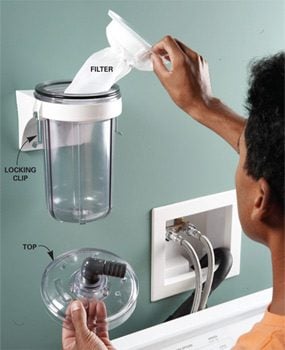Septic System: How to Filter Out Laundry Lint
Updated: Jun. 24, 2019The secret? Keep the lint out

Lint catcher for washing machine: Mount the filter holder
One major cause of septic field failure is washing machine lint—mostly from synthetic fibers that never degrade, such as nylon and polyester, but also from natural fibers like cotton that degrade very slowly. Eventually this lint can create impenetrable mats in the soil surrounding the drain lines, preventing liquid from being readily absorbed. Fortunately, preventing this problem can be as simple as putting a high-quality filter on your laundry machine discharge hose.
Inexpensive, sock-type lint filters or drain baskets catch bigger fibers, but most of the lint washes right through—and you can’t even use them unless your washer discharges into a laundry tub. A better choice is an enclosed, very fine mesh filter that captures more than 90 percent of the lint. It’s not cheap, but it’ll add years of service to your drain field.
Installation is simple. Mount the filter holder on the wall near the laundry tub or discharge pipe. Slip in the filter (Photo 1), lock the top down and attach the discharge hoses to the filter container (Photo 2). Remove the reusable filter bag and empty it when it’s half full (usually after about 8 to 15 loads). If you forget to change the filter, the water just drains around it, so there’s no danger of overflow. Replacement filters are a bit expensive, rarely need replacing according to the manufacturer.
Septic protector filters are available from the manufacturer (Septic Protector Filtrol 160; septicprotector.com), local septic supply companies, and online.
Required Tools for this Washing Machine Lint Trap Project
Have the necessary tools for this DIY project lined up before you start—you’ll save time and frustration.
- 4-in-1 screwdriver
- Cordless drill
Required Materials for this Washing Machine Lint Trap Project
Avoid last-minute shopping trips by having all your materials ready ahead of time. Here’s a list.
- Drywall anchors
- Hose clamps
- Septic lint filter


